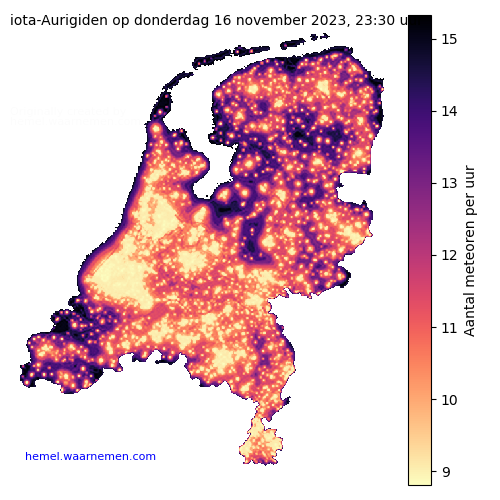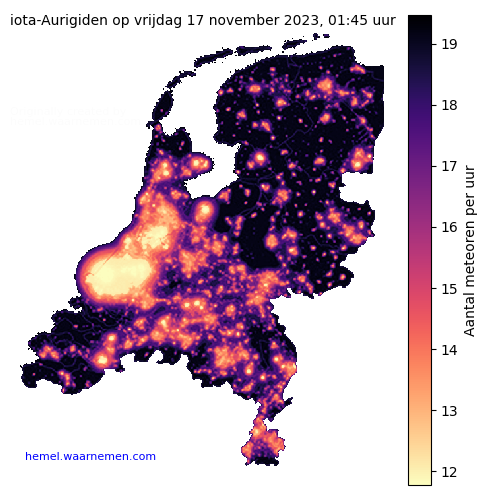In de geschiedenis
Links:
Wikipedia
Links:
Wikipedia
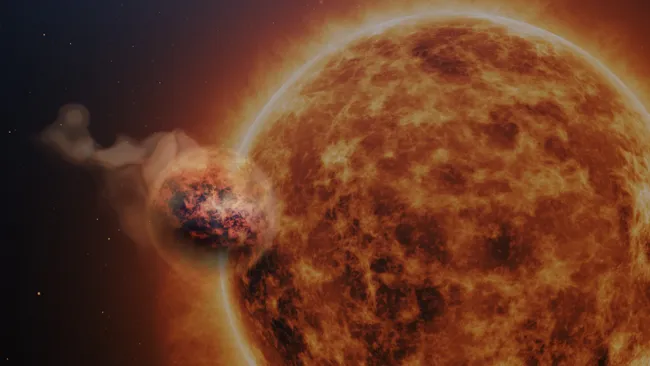
WASP-107b is a super-Neptune exoplanet that orbits the star WASP-107. It lies 200 light-years away from Earth in the constellation Virgo, its discovery was announced in 2017 by a team led by D. R. Anderson via the WASP-South.
WASP-107b could not have formed in its current orbit. It likely migrated inward from its birth orbit beyond 1 AU due to interaction with the heavier planet WASP-107c. WASP-107b is in a retrograde orbit, strongly misaligned with the equatorial plane of the parent star. The misalignment angle is equal to 118°+38 −19. WASP-107c follows a highly eccentric and inclined orbit with a period of 1088+15 −16 days. WASP-107b is a super-Neptune ice giant exoplanet located 200 light years away from Earth in the constellation Virgo. It is roughly the size of Jupiter but less than one-tenth of Jupiter’s mass, making it one of the lowest density exoplanets. Its radius is 0.96±0.03 times Jupiter’s, making its atmosphere fluffy, and coupled with transiting a moderately bright K-type star, makes it a target for atmospheric characterization. It is eight times nearer to its star than Mercury is to the Sun and orbits its star every 5.7 days. With a temperature of 773K / 500 °C, its atmosphere makes it one of the hottest known exoplanets. Helium was discovered in the planet’s atmosphere in 2018, making it the first time helium was discovered on an exoplanet. A follow-up observation with Keck in 2020 showed that the helium absorption extends beyond transit-egress. Extreme ultraviolet radiation from the host star is gradually whittling down the planet’s atmosphere, forming a comet-like tail 7 times as long as the radius of the planet.
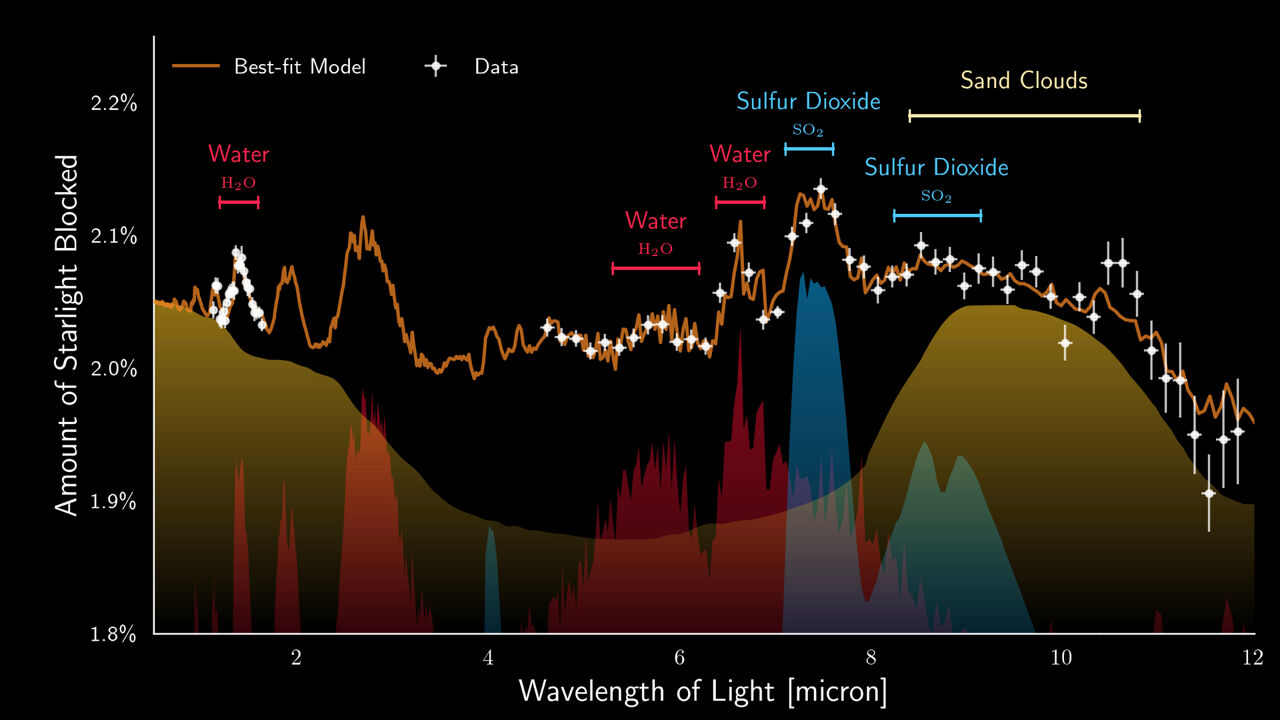
While the James Webb Space Telescope (JWST or Webb) may spend a lot of its time observing the farthest reaches of the early universe when galaxies were only just starting to form, it also spends plenty of its time focused on objects a lot closer to home — such as the atmospheres of exoplanets in our galactic neighborhood. A team of European astronomers, co-led by researchers from the KU Leuven Institute of Astronomy, used observations from the JWST to detail the atmospheric composition of the exoplanet WASP-107b. The researchers found water vapor, sulfur dioxide and even silicate sand clouds residing within the exoplanet’s dynamic atmosphere. The study ‘SO2, silicate clouds, but no CH4 detected in a warm Neptune‘ may also have implications for our understanding of the chemistry of distant planets.
Links:
James Webb Space Telescope reveals sandy surprise in distant planet
Alien Atmosphere: Webb Detects Water Vapor, Sulfur Dioxide and Sand Clouds in Nearby Exoplanet
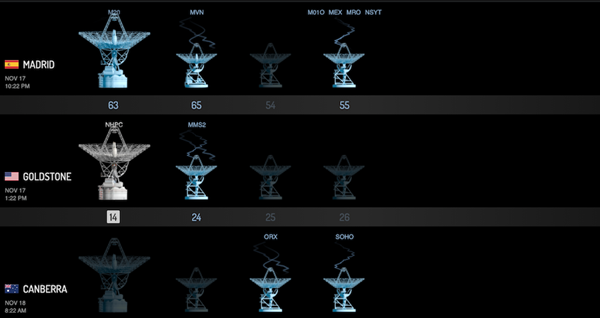
The NASA Deep Space Network (DSN) formally announced its intention to send missions into deep space on 24 December 1963; it has remained in continuous operation in one capacity or another ever since.
The Deep Space Network is a worldwide network of American spacecraft communication ground segment facilities, located in the United States (California), Spain (Madrid), and Australia (Canberra), that supports NASA’s interplanetary spacecraft missions. It also performs radio and radar astronomy observations for the exploration of the Solar System and the universe, and supports selected Earth-orbiting missions. DSN is part of the NASA Jet Propulsion Laboratory (JPL).
Links:
Deep Space Network
The Deep Space Network: How NASA spacecraft make long-distance calls

De Publieke Tribune is zowel een televisie– als radioprogramma van HUMAN.
Het radioprogramma wordt sinds 1 januari 2022 het programma wekelijks op zaterdag om 15:00 uitgezonden op NPO Radio 1. In het programma praat presentator Coen Verbraak met ervaringsdeskundige gasten over een actueel onderwerp of maatschappelijke kwestie.
In deze uitzending van De Publieke Tribune spreekt Coen Verbraak met drie gasten over de verspreiding van misleidende producten en gezondheidsadviezen. Dokters zijn bezorgd over het groeiende aantal bekende Nederlanders en influencers dat via sociale media misleidende gezondheidsadviezen verspreidt. En ook gevestigde media, zoals tijdschriften en talkshows, maken zich weleens schuldig aan het populariseren van ongefundeerde gezondheidsclaims. Hoe herken je dit soort kwakzalverij? Wat merken artsen ervan in de spreekkamer? En wat moeten we doen om het te bestrijden?
Links:
De Publieke Tribune 118. Kwakzalverij (opnieuw beluisteren)

Nederlandse kinderen zijn hele beroerde lezers en het slagingspercentage op middelbare scholen daalde voor het eerst, sinds 2012, onder de 90 procent.
Het is lastig om mensen te enthousiasmeren voor het vak leraar én nog lastiger om ze vast te houden. Terwijl de overheid steeds meer geld in het onderwijs investeert. Waar gaat dat geld naartoe? Follow The Money (FTM) wil het weten en jonge onderzoeksjournalisten kunnen helpen. In dit programma worden de beste pitches samen met FTM besproken. Aansluitend gaan we in gesprek met onder anderen een hoogleraar onderwijskunde en de onderwijsjournalisten van FTM. Als klapper op de vuurpijl worden de winnende pitches bekendgemaakt. Waar blijft het geld dat we investeren in het onderwijs? Wie bepaalt waaraan het wordt uitgegeven? Hoe kan extra geld niet zorgen voor meer leraren en betere schoolprestaties? Help FTM door een onderzoeksvoorstel in te dienen, je dienst aan te bieden, je kennis te delen en door te stemmen op een ingediende pitch.
Links:
De prijs van ons onderwijs
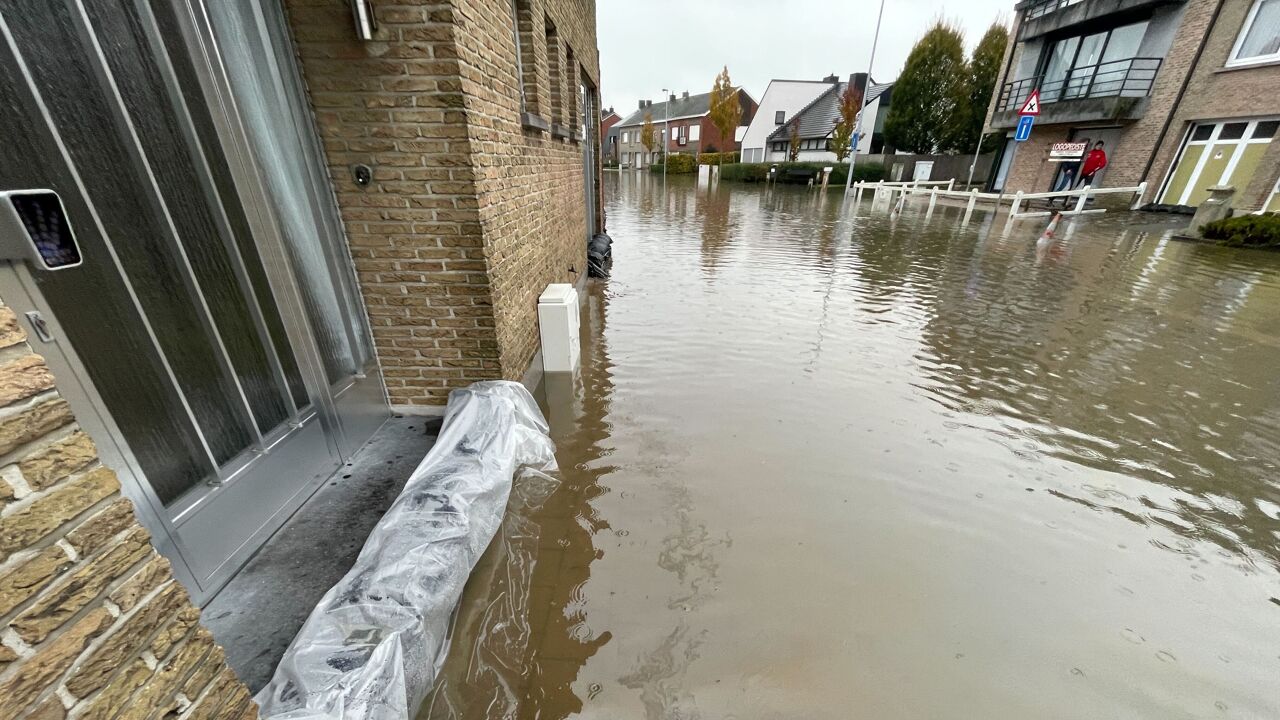
Door aanhoudende regenval zijn er medio november 2023 in de kuststreken van West-Vlaanderen en Noordwest-Frankrijk (de Westhoek) grote problemen ontstaan door hoogwater en overstromingen, de bodem is verzadigd doordat het gebied al dagenlang geteisterd wordt door hevige regenval, rivieren en beken zijn buiten hun oevers getreden en dorpen staan onder water.
Links:
Waarschuwingen voor wateroverlast in Noord-Frankrijk en België
Watersnood in Westhoek wordt “hoogstwaarschijnlijk” erkend als ramp

In September 2020, the UN General Assembly adopted resolution A/RES/74/299 “Improving global road safety”, proclaiming the Decade of Action for Road Safety 2021-2030, with the ambitious target of preventing at least 50% of road traffic deaths and injuries by 2030.
WHO and the UN regional commissions, in cooperation with other partners in the UN Road Safety Collaboration, have developed a Global Plan for the Decade of Action, which was released in October 2021. The Global Plan aligns with the Stockholm Declaration, by emphasizing the importance of a holistic approach to road safety, and calling on continued improvements in the design of roads and vehicles; enhancement of laws and law enforcement; and provision of timely, life-saving emergency care for the injured. The Global Plan also reflects the Stockholm Declaration’s promotion of policies to promote walking, cycling and using public transport as inherently healthy and environmentally sound modes of transport. Progress made during the previous Decade of Action for Road Safety 2011-2020 has laid the foundation for accelerated action in the years ahead. Among achievements are inclusion of road safety on the global health and development agenda, broad dissemination of scientific guidance on what works, strengthening of partnerships and networks, and mobilization of resources. This new Decade of Action provides an opportunity for harnessing the successes and lessons of previous years and building upon them to save more lives.
Links:
Decade of Action for Road Safety 2021-2030
#WDoR2023 World Day of Remembrance for Road Traffic Victims 2023
Donderdag; Fagradalsfjallvulkaan – (mogelijke) uitbarsting; Tweede Kamerverkiezingen 2023; glyfosaat; World Philosophy Day; Wereld Dag van de Tolerantie; Arecibo message; Meteorenzwerm ι-Aurigiden.

Knipselkrant:
Agenda:
Weer:
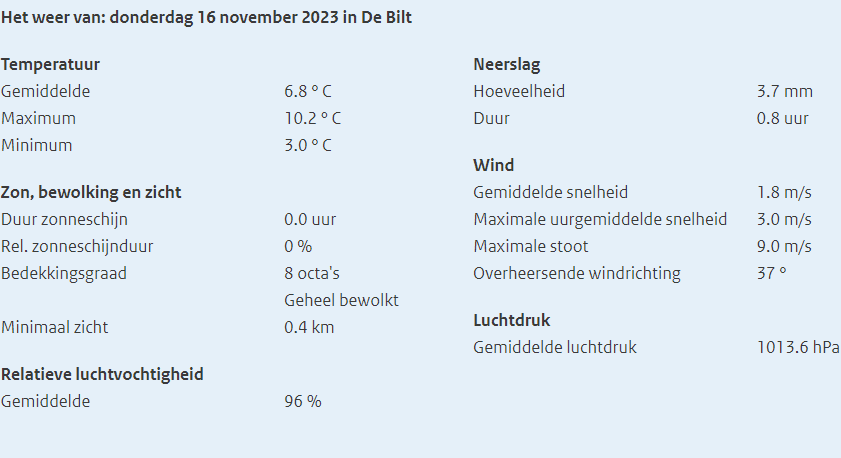
Links:
In de geschiedenis
Links:
Wikipedia
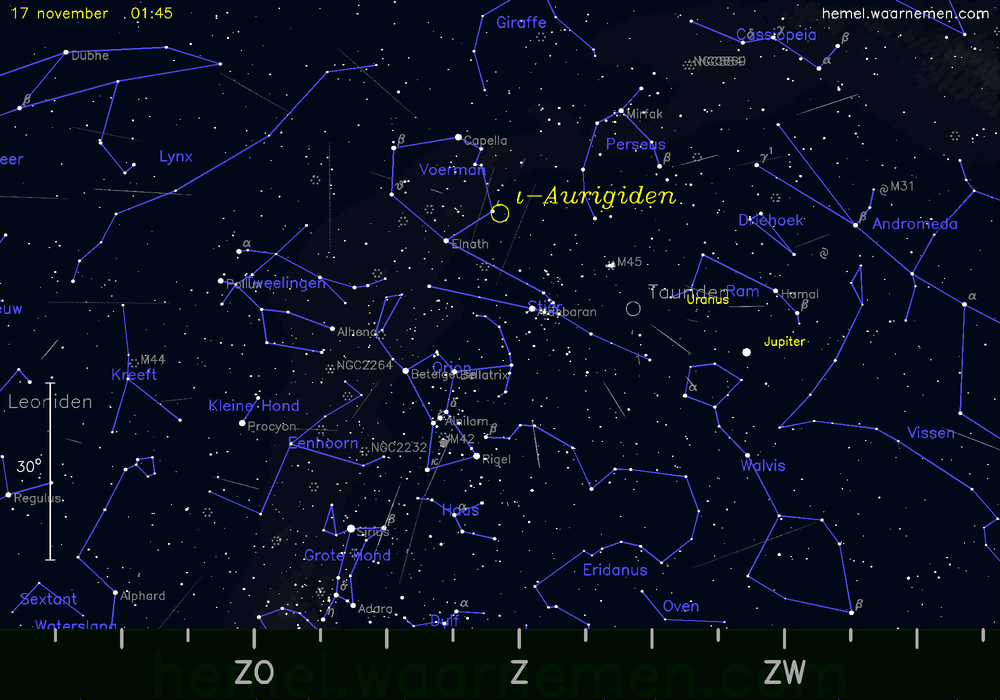
De meteorenzwerm ι-Aurigiden bereikt op donderdag 16 november 2023, rond 16:00, zijn maximum.
Wanneer de radiant in het zenit zou staan, zouden er van deze zwerm naar verwachting gemiddeld zo’n 8 meteoren per uur vallen. Rond 02:00 staat de radiant van de zwerm in het hoogste punt (op 71°) aan de hemel. Bij ons zijn ieder uur vermoedelijk ongeveer 6 meteoren zichtbaar van deze zwerm. Samen met meteoren van andere zwermen, en sporadische meteoren, zijn er bij donkere, heldere hemel in totaal circa 19–28 “vallende sterren” per uur te zien. Op een goed donkere plek zijn meer dan twee keer zoveel meteoren te zien als in dichtbevolkt gebied. De Maan stoort niet. Rond 07:30 gaat het schemeren en om 08:03 komt de Zon op. De meteoren van de meeste zwermen verschijnen niet allemaal op de dag van het maximum. Zo is gedurende circa 9 dagen rondom het maximum ruim 50% van het maximum aantal meteoren per uur (3) van de ι-Aurigiden te zien. Tot 10 dagen voor en na het maximum zijn nog meteoren van deze zwerm te herkennen. Probeer dus ook enkele nachten voor en na het maximum meteoren waar te nemen. Iedere dag verder weg van het maximum zijn er echter wel ongeveer 10% minder meteoren per uur te zien. De typische snelheden van de meteoren in deze zwerm zijn met circa 34 km/s (ongeveer 122.760 km/uur) vrij gemiddeld. Er is geen speciale apparatuur nodig om meteoren waar te kunnen nemen.
